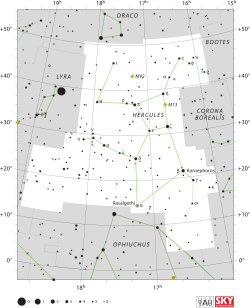106 Herculis
| 106 Herculis | |
 | |
| Observationsdata Epok: J2000.0 | |
|---|---|
| Stjärnbild | Herkules |
| Rektascension | 18t 20m 17,91482s[1] |
| Deklination | +21° 57′ 40,6622″[2] |
| Skenbar magnitud () | +4,96[3], +4,9 - 4,95 (V)[4] |
| Stjärntyp | |
| Spektraltyp | M0 III[5] |
| U–B | 1,98[6] |
| B–V | +1,594 ± 0,011[7] |
| Variabeltyp | Halvregelbunden variabel (SR:)[4][8][9] |
| Astrometri | |
| Radialhastighet () | -35,20 ± 0,29[10] km/s |
| Egenrörelse (µ) | RA: 18,105 ± 0,173[1] mas/år Dek.: -59,631 ± 0,285[1] mas/år |
| Parallax () | 8,5067 ± 0,1739[1] |
| Avstånd | 383 ± 8 lå (118 ± 2 pc) |
| Absolut magnitud () | -0,664[10] |
| Detaljer | |
| Radie | 44,32+2,70-5,89[1] R☉ |
| Luminositet | 414,1 ± 9,7[1] L☉ |
| Temperatur | 3 789 ± 6[5] K |
| Metallicitet | 0,00 ± 0,03(Fe/H)[5] dex |
| Vinkelhastighet | 5,0 ± 1,0[11] km/s |
| Andra beteckningar | |
| HD 168720[12], HIP 89861[12], HR 6868[12], IRAS 18181+2156[12], SAO 85941[12], 2MASS J18201792+2157405[12], GSC 01580-02157[12], BD+21 3390[12], GC 25033[12], GCRV 10815[12], HIC 89861[12], IRC +20361[12], JP11 2961[12], NSV 24405[12], PLX 4214[12], PLX 4214.00[12], PPM 107091[12], RAFGL 2128[12], TD1 22217[12], TYC 1580-2157-1[12], UBV 15608[12], YZ 21 6416[12], DO 16685[12], YPAC 574[12], WEB 15343[12], Gaia DR2 4529690183608965504[12], 106 Her, TIC 333059225[12], Gaia DR3 4529690183608965504[12], AG+21 1818[12] och UBV M 22863[12] [13] | |
106 Herculis, som är stjärnans Flamsteed-beteckning, är en ensam stjärna i den östra delen av stjärnbilden Herkules. Den har en lägsta skenbar magnitud på ca 4,96[3] och är svagt synlig för blotta ögat där ljusföroreningar ej förekommer. Baserat på parallaxmätning inom Hipparcosuppdraget på ca 8,5[1] mas, beräknas den befinna sig på ett avstånd på ca 383 ljusår (ca 118 parsek) från solen. Den rör sig närmare solen med en heliocentrisk radialhastighet på ca –35 km/s.[10]
Egenskaper[redigera | redigera wikitext]
106 Herculis är en röd till orange jättestjärna av spektralklass M0 III.[6] Den har en radie som är ca 44[1] solradier och utsänder ca 414[1] gånger mera energi än solen från dess fotosfär vid en effektiv temperatur på ca 3 800 K.[5]
106 Herculis är en pulserande variabel av förmodad halvregelbunden typ (SR:),[4] som har skenbar magnitud +4,9 till 4,95[4] och varierar med en mycket liten amplitud och en period av minst 40 dygn.[9] Eggleton och Tokovinin (2008) listade den som en misstänkt dubbelstjärna bestående av två ungefär likvärdiga komponenter.[14]
Se även[redigera | redigera wikitext]
Referenser[redigera | redigera wikitext]
- Den här artikeln är helt eller delvis baserad på material från engelskspråkiga Wikipedia, 106 Herculis, 24 januari 2020.
Noter[redigera | redigera wikitext]
- ^ [a b c d e f g h i] Brown, A. G. A.; et al. (Gaia collaboration) (August 2018). "Gaia Data Release 2: Summary of the contents and survey properties". Astronomy & Astrophysics. 616. A1. arXiv:1804.09365. Bibcode:2018A&A...616A...1G. doi:10.1051/0004-6361/201833051. Gaia DR2 record for this source at VizieR.
- ^ ”Basic data: V* 106 Her – High proper-motion Star” (på engelska). Centre de Données astronomiques de Strasbourg. http://simbad.u-strasbg.fr/simbad/sim-basic?Ident=106+Her&submit=SIMBAD+search. Läst 2 september 2019.
- ^ [a b] J. R., Ducati (2002). "VizieR Online Data Catalog: Catalogue of Stellar Photometry in Johnson's 11-color system". CDS/ADC Collection of Electronic Catalogues. 2237. Bibcode:2002yCat.2237....0D.
- ^ [a b c d] ”NSV 24405” (på engelska). The International Variable Star Index. AAVSO – American Association of Variable Star Observers. http://www.aavso.org/vsx/index.php?view=detail.top&oid=62840. Läst 2 september 2019.
- ^ [a b c d] Wu, Yue; et al. (2010). "Coudé-feed stellar spectral library – atmospheric parameters". Astronomy & Astrophysics. 525: A71. arXiv:1009.1491. Bibcode:2011A&A...525A..71W. doi:10.1051/0004-6361/201015014.
- ^ [a b] Mermilliod, J.-C. (1986). "Compilation of Eggen's UBV data, transformed to UBV (unpublished)". Catalogue of Eggen's UBV Data. Bibcode:1986EgUBV........0M.
- ^ van Leeuwen (2007). ”Hipparcos, the New Reduction” (på engelska). http://vizier.u-strasbg.fr/viz-bin/VizieR-5?-out.add=.&-source=I/311/hip2&HIP=89861. Läst 2 september 2019.
- ^ Samus, N. N.; Durlevich, O. V.; et al. (2009). "VizieR Online Data Catalog: General Catalogue of Variable Stars (Samus+ 2007-2013)". VizieR On-line Data Catalog: B/gcvs. Originally Published in: 2009yCat....102025S. 1: B/gcvs. Bibcode:2009yCat....102025S.
- ^ [a b] Percy, John R. (1993). "The photometric variability of K giants". Publications of the Astronomical Society of the Pacific. 105: 1422. Bibcode:1993PASP..105.1422P. doi:10.1086/133324.
- ^ [a b c] Soubiran, C.; Bienaymé, O.; Mishenina, T. V.; Kovtyukh, V. V. (2008). "Vertical distribution of Galactic disk stars". Astronomy & Astrophysics. 480: 91. arXiv:0712.1370. Bibcode:2008A&A...480...91S. doi:10.1051/0004-6361:20078788.
- ^ Zamanov, R. K.; et al. (October 2008). "Rotational velocities of the giants in symbiotic stars - III. Evidence of fast rotation in S-type symbiotics". Monthly Notices of the Royal Astronomical Society. 390 (1): 377–382. arXiv:0807.3817. Bibcode:2008MNRAS.390..377Z. doi:10.1111/j.1365-2966.2008.13751.x.
- ^ [a b c d e f g h i j k l m n o p q r s t u v w x y z aa ab ac ad] SIMBAD Astronomical Database.[källa från Wikidata]
- ^ "106 Her". SIMBAD. Centre de données astronomiques de Strasbourg. Hämtad 2019-06-17.
- ^ Eggleton, P. P.; Tokovinin, A. A. (September 2008). "A catalogue of multiplicity among bright stellar systems". Monthly Notices of the Royal Astronomical Society. 389 (2): 869–879. arXiv:0806.2878. Bibcode:2008MNRAS.389..869E. doi:10.1111/j.1365-2966.2008.13596.x.





